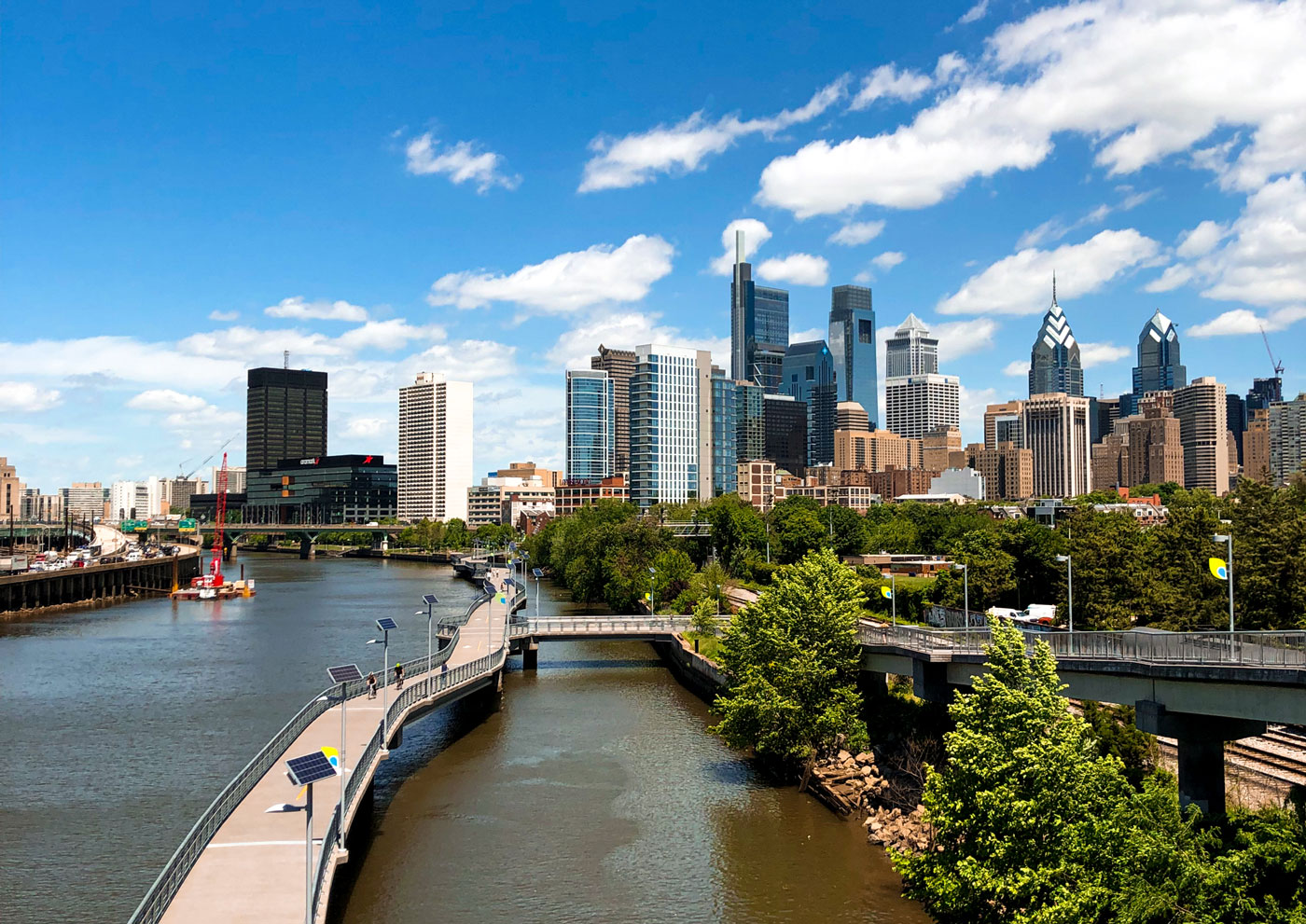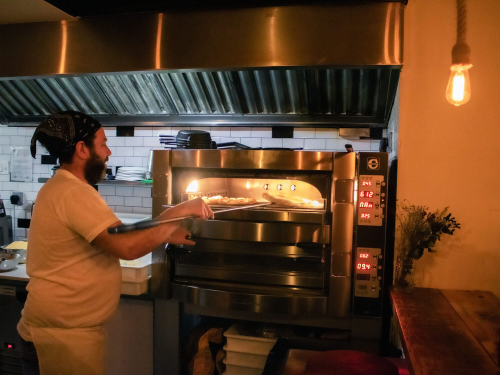
Philadelphia is most known for being the birthplace of America. It was here where the nation’s Founding Fathers signed the Declaration of Independence and later, deliberated over our nation’s Constitution. It’s central location within the original 13 colonies made it not just an important city for politics, but also a hub for culture.
During the 18th and 19th centuries, Philadelphia was one of the largest ports in the Western Hemisphere. Through its shores came a wealth of ingredients from across the globe – spices, coffee, tea, and chocolate to name a few. In addition to the food coming from overseas, the Mid-Atlantic region was bountiful. The Delaware river was bursting with oysters and fish and thanks to the rich soils and temperate seasons, nearby farms were able to harvest abundant crops of produce.
Today, the city remains a cultural hub, blending international influences with ingredients sourced from local farms and purveyors, creating a cuisine that is uniquely Philadelphian.
PHILADELPHIA’S FIRST PEOPLE
Before William Penn settled what would become Philadelphia and the state of Pennsylvania, the indigenous Lenni Lenape lived in the region calling it Lenapehoking. Influences of the Lenape culture can still be seen today in the names of places which were oftentimes named after the foods that were found there. The Wissahickon, which means “catfish stream,” “Tulpehocken,” meaning “land of the turtles,” and Manayunk, which means “place where we go to drink” are a few examples.
Traces of Lenape culinary traditions can also be found in the region’s cuisine. When settlers arrived, the Lenape shared their intimate knowledge of indigenous foods with them, teaching them where to find, how to cultivate, and how to prepare the region’s bounty. They introduced settlers to squash, corn, and beans, a trio known to the Lenape as the Three Sisters. The Lenape also taught settlers how to hunt the indigenous wild turkey, deer, and turtle, and showed them how to fish for catfish and the shad, a freshwater fish found along the East Coast. All of these ingredients continue to show up in a multitude of Mid Atlantic dishes, but are often used and expressed in different ways depending on the cultural influences of the many immigrant communities who have come here.
EARLY EUROPEAN SETTLERS
Parts of Philadelphia’s early colonial cuisine is a blend European influences incorporating ingredients from the region. Scrapple is made with pork scraps that can’t be used in other dishes. The pork scraps are seasoned with herbs and cooked down to a mush that is then formed into a savory loaf. The dish, which helped reduce food waste and had a long shelf life, was brought over by German settlers who had a very similar dish called Pannhaas. What makes scrapple different from the traditional Pannhaas is the introduction of cornmeal, which was a uniquely North American ingredient. Scrapple remains a very popular breakfast meat throughout Philadelphia and the local region.

English influences can also be found in Philadelphia’s cuisine, most notably in the famous snapper soup. Snapper soup is Philadelphia’s take on a broader category of turtle soups which incorporate turtle meat, vegetables, and spices. The traditional Philadelphia snapper soup has a rich, meaty broth that is given an extra kick of spice with a pepper sherry that is added right before serving. Though snapper turtles were abundant in the region, Philadelphians originally preferred Green Sea Turtles and Diamondback terrapins for their turtle soups, only moving onto the snapper turtle after the other species were hunted to near extinction.
THE AFRICAN DIASPORA
The African Diaspora’s influence on Philadelphia cuisine can be traced back to colonial times when many chefs were of African descent. Pepperpot, a meat and vegetable stew spiced with herbs and peppers, has many variations throughout the Caribbean, but found its way to Philadelphia by way of the slave trade. Caribbean women would source spices and peppers straight from the ships that came to Philadelphia’s ports and would make huge batches of pepperpot soup. The Philadelphia pepperpot soup was made with beef tripe, potatoes, carrots, peppers, spices, and leafy greens and was served on the streets as well as a in taverns. It’s also said that pepperpot was the dish that fed George Washington’s troops and kept them from freezing during the Revolutionary War.

The Great Migration of the early to mid 20th Century was also a defining moment in Philadelphia food history. Around 6 million African Americans left the South, moving to cities in the Northeast, Midwest and West. The new population of African Americans in cities such as Philadelphia, changed not just the cultural landscape but also the culinary landscape. Soul food, fried seafood, and barbecue became part of Philadelphia’s growing cuisine.
By the early 2000’s, African-born immigrants became one of the fastest-growing communities in Philadelphia with the largest group coming from Ethiopia. Most of these Ethiopian, Senegalese, Ghanaian, Nigerian, Sierra Leonean, and Liberian immigrants moved to neighborhoods in West Philadelphia and Southwest Philadelphia, which in recent years has been referred to as Little Africa. These communities have opened up restaurants and grocery stores, making the many nuanced African cuisines more readily available.
THE ITALIAN MIGRATION
During the late 19th Century and early 20th Century, Italians, predominantly from southern Italy, immigrated to the United States, settling mostly in Boston, New York, Philadelphia, Washington D.C., and the surrounding areas. Of those who came to Philadelphia, most moved to neighborhoods in South Philadelphia. On 9th Street just north of Washington Avenue, many set up family restaurants and businesses selling produce, fresh pastas, high quality meats, and other Italian goods. Carts filled with goods lined both sides of 9th Street, earning the neighborhood the name Italian Market. Today, the Italian Market is still a place for locals to buy premium meats, artisan cheeses, fresh seafood, and local produce.



Though regional cuisines throughout Italy are distinct, Italians who immigrated to America adapted their foods, creating a culinary tradition that is uniquely Italian-American. There are numerous restaurants throughout Philadelphia serving Italian-American classics like red sauce (gravy as many Italian-American Philadelphians like to call it), pasta, seafood (many families still have the Feast of Seven Fishes on Christmas Eve), and traditional Italian baked goods like traditional breads, cannoli, biscotti, and tiramisu. In recent years, a new generation of Italian American chefs have started focusing on their specific Italian heritages, bringing the regional Italian cuisines of Sicily, Abruzzo, Naples, and Rome to Philadelphia.
"Philadelphia is home to the world’s first pizza museum..."
One of the most popular Italian-American contributions to American cuisine is pizza, which is prevalent throughout Philadelphia and a must try for pizza-loving visitors. In 2006, Serious Eats’ founder Ed Levine published Pizza: A Slice of Heaven in which he discusses The Pizza Belt Theory. Levine pointed out that some of America’s earliest and arguably best pizzas come from the Northeastern corridor stretching from Philadelphia through New York City all the way north to Boston, an area he deems as The Pizza Belt. The theory says that the immigration of Italians to these cities likely gave way to the Neapolitan-American pizza. Since the 20th Century when many Italian-American families opened pizza shops, pizza has become a staple in Philadelphia cuisine. Philadelphia is home to the world’s first pizza museum and there are numerous restaurants where the legendary pie has been refined and, in some cases, redefined.
NEW GENERATIONS OF IMMIGRANTS
Philadelphia’s food is shaped by generations of immigrants who have made this city their home. And with every new generation comes a new layer of nuance and complexity that gets added to our local cuisine.
In recent decades, increasing populations of Latin American communities coming to neighborhoods in South Philadelphia and the Italian Market have changed the culinary landscape. There are lots of restaurants serving barbacoa, ceviche, elote, tamales, tacos, burritos and other Mexican and Mexican American dishes in South Philadelphia, but restaurants taking authentically Philadelphian foods and adding a Latin American twist are on the rise.


Though many pizza shops in Philadelphia are owned and operated by Italian-American families, pizza has become an art form expressed through numerous cultural lenses, most notably in Philadelphia’s growing number of Mexican pizzas. Instead of topping pizzas with more familiar meats like Italian sausage and pepperoni, Mexican pizzas come with toppings like chicken mole, roasted peppers, chorizo, corn, and marinated pork with pineapple inspired by traditional Mexican-Lebanese dish, al pastor.
CHEESESTEAKS REIMAGINED
One of Philadelphia’s most recognizable dishes is the Philadelphia Cheesesteak, a roll filled with chopped steak, cheese, and sometimes sautéed onions, depending on your personal preferences. Though this classic sandwich can be found at restaurants, bars, and in food carts, the cheesesteak is one of the most commonly adapted dishes Philly. There are cheesesteak bao buns, cheesesteak egg rolls, cheesesteak empanadas, seafood cheesesteaks, and halal cheesesteaks, to name a few variations.


ENTREPRENEURSHIP WITH A PRETZEL TWIST
To say that Philadelphians love pretzels is an understatement. According to several Philadelphia publications, Philadelphians eat 12 times more pretzels than the average American. Philadelphians love pretzels so much that the city officially declared April 26th as National Pretzel Day. Though the pretzel has a long tradition in Germany, Philadelphia has developed its own unique style of pretzel.
Pretzels were another food introduced by German immigrants, but it was the Italian-American Nacchio family who developed and popularized the Philadelphia-style pretzel. Like German pretzels, the Philadelphia-style pretzel is a large, doughy pretzel that’s soft on the inside with a firm, sometimes lightly crusted outside that’s baked until golden brown.

Aside from variations in the recipe, the Philadelphia-style pretzel has two holes, instead of the recognizable three holes. It has a figure-eight shape because around the 1920’s the Nacchio family started mass producing soft pretzels with a conveyor belt machine imported, ironically enough, from Germany. The convenient shape not only allowed pretzels to be made faster and in larger quantities, but allowed for easy distribution to street vendors, many of whom were entrepreneurial immigrants.
Related Articles
-
 Travel & Culture March 16, 2020 | 6 min read Significance of Sustenance: Burlington I grew up in the shadow of the slopes in the Pocono Mountains, but the icy Pennsylvania conditions made skiing decidedly unfun for fall-prone little-ol’ me.
Travel & Culture March 16, 2020 | 6 min read Significance of Sustenance: Burlington I grew up in the shadow of the slopes in the Pocono Mountains, but the icy Pennsylvania conditions made skiing decidedly unfun for fall-prone little-ol’ me. -
 Travel & Culture April 02, 2020 | 8 min read A Brooklyn Pizzeria Fights Through COVID-19 COVID-19 hit the city like a slow-moving hurricane. We knew it was coming, but we were still in shock. Everything was uncertain.
Travel & Culture April 02, 2020 | 8 min read A Brooklyn Pizzeria Fights Through COVID-19 COVID-19 hit the city like a slow-moving hurricane. We knew it was coming, but we were still in shock. Everything was uncertain. -
 Travel & Culture June 23, 2020 | 6 min read Distinctive Process: Maori Hangi Steaming geothermal pools set against a vivid blue sky, in the middle of lush natural surroundings and a day spent soaking up indigenous Maori culture.
Travel & Culture June 23, 2020 | 6 min read Distinctive Process: Maori Hangi Steaming geothermal pools set against a vivid blue sky, in the middle of lush natural surroundings and a day spent soaking up indigenous Maori culture.
